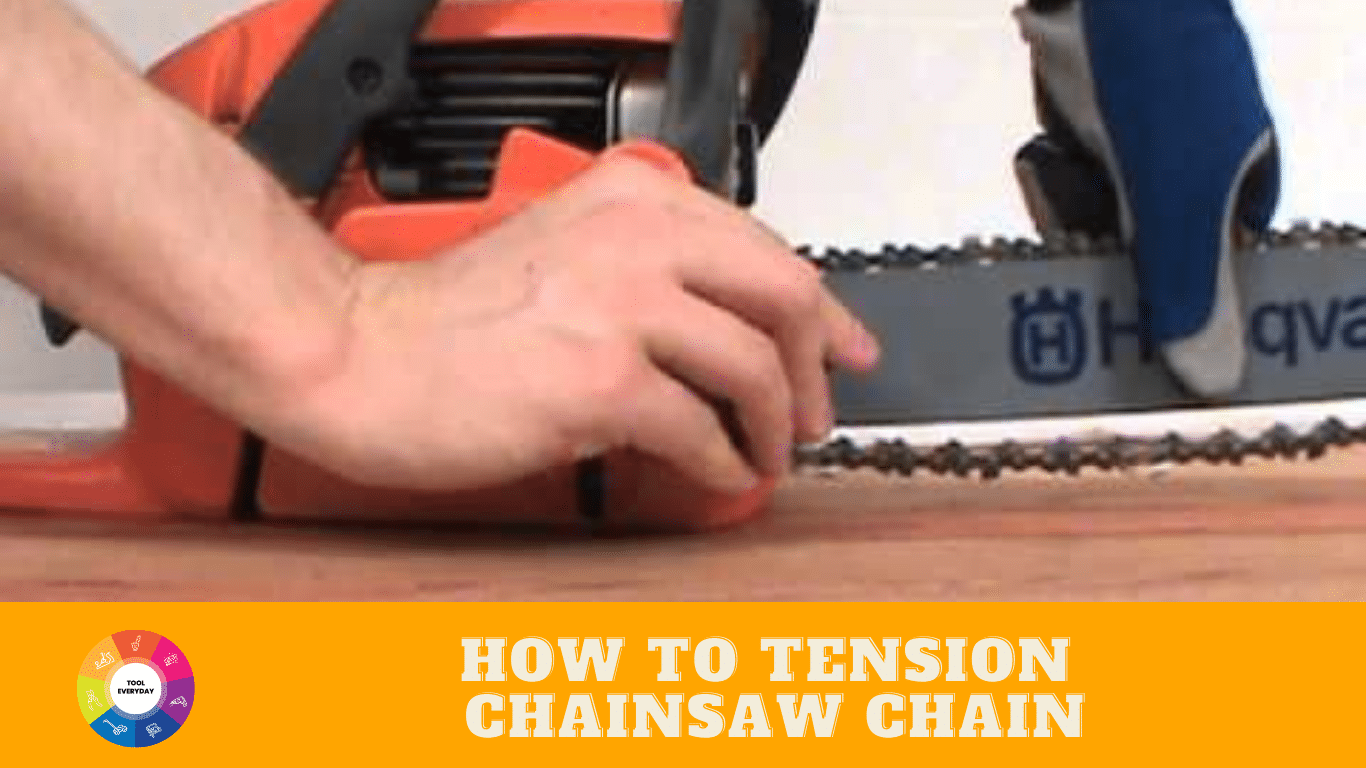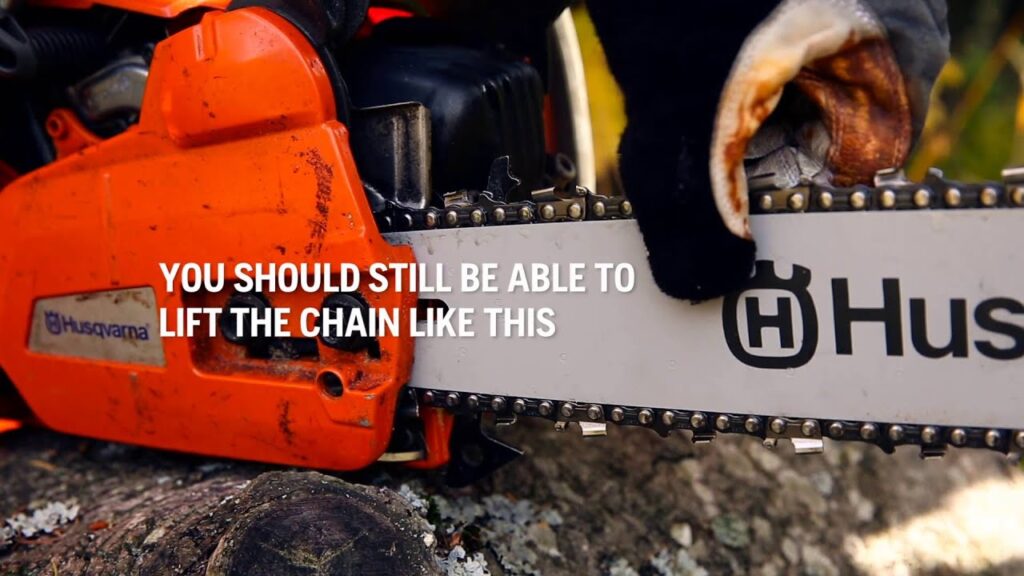Maintaining proper chain tension in your chainsaw is paramount for optimal performance. It’s essential to check the tension before starting work and frequently while working with it, as a loose chainsaw chain increases the likelihood of kickback or the saw chain being derailed from the guide bar.
Meanwhile, if the saw chain it’s too tight, it might not turn correctly or even overheat the chainsaw, putting you at risk of fires and drastically cutting its lifespan. So, follow these steps when adjusting your chainsaw chain to ensure it has the correct tension.
What Is The Correct Chainsaw Chain Tension?
Before we delve into how to tension a chainsaw chain, it is essential to understand what appropriate chain tension looks like.
Good Chain Tension
The chain on your chainsaw should be slightly loose and never tight enough to pull the drive links out of the bar nose. To check if your chain tension needs to be adjusted, pull the chain lightly away from the guide bar – if the drive links stay engaged, no adjustment is necessary.
Bad Chain Tension
As before, pull the chainsaw chain gently away from the bar nose, but if you can pull it free, then your chain tension is too loose and needs to be tightened. Also, beware of over-tightened chains — signs of this include excessive wear on the drive links or difficulty turning the chain by hand when the engine is stopped.
What Happens If You Don’t Tension Your Chainsaw Chain Regularly?
You may face serious consequences if you don’t tension your chainsaw chain as needed. A loose chain might cause kickback — an abrupt force that can throw you off the machine and injure you or those around you. If a chain is too tight, it will cause excessive wear on the drive links and overheat the machine, significantly reducing its lifespan. Plus, an overly-tight chain might prevent the engine from starting. Therefore, tensioning your chainsaw chain to avoid these issues and maintain a safe working environment is essential.
Tool(s) You Need
- A scrench (a screw/wrench combo)
- A flathead screwdriver
How to Tension a Chainsaw Chain
Before you start tensioning your chainsaw chain, the engine of your chainsaw power device must be shut off. Additionally, it should only be done while the tool is cold and not overheated.
Now let’s go step by step on how to tension your chainsaw chain correctly:
1. Turn Off The Chainsaw And Let It Cool Down
Start by turning off the machine and disconnecting any fuel sources — i.e., unplugging the cord for electric models or removing the spark plug for gas-powered ones. Never make adjustments while it is running. Also, don’t carry out any adjustments when the chainsaw is hot. Allow it to cool down completely.
2. Locate The Chain Tensioning Adjustment Pin/Screw
Most chainsaw brands come with a chain-tensioning adjustment screw on the side of the chainsaw body. You can easily locate it near the bolts at the base of the chainsaw bar. This adjustment mechanism resembles a flathead screw, but it is a pin that moves the chainsaw bar slightly to loosen or create tension on the chain.
3. Loosen The Bolt(s) That Holds The Chainsaw Bar
Before you adjust the tensioning pin, loosen the bolts that secure the side plate. Use a scrench with a socket end for this task and only loosen these bolts about 1/2-turn. This will give you some wiggle room in the chainsaw bar under the side plate. You don’t need to remove them — loosening them slightly is enough to adjust the chain tension. Now, you can start tightening the chain.
4. Use The Scrench For Adjusting The Tensioning Pin/Screw
Loosen the bolts or bolts (if there is more than one) on both sides of the chainsaw. Use the screwdriver part of the scrench into a flathead tensioning pin and turn it clockwise to tighten the chain. In reality, though, this process isn’t tightening anything. Instead, as you rotate that tensioning pin outwardly with every movement, any slack between the chainsaw bar and its chain is taken up.
Depending on your work, you may need to repeat this process now and then. You may need to adjust the chain—at least—thrice after 2-4 hours of a wood-cutting session. So keep your scrench at hand.
5. Check The Chain’s Tension When It’s Tight Enough
How tight is too tight? To be honest, there is no measuring gauge the determine the right amount of tension on the chain. But there is a simple trick that can help. After adjusting the tensioning pin, hold the bottom part of the saw between your thumb and finger, then pull it downward. If you see a slight gap between each link and bar, it means the chain is adequately tight. However, ensure that all the inner-tip links return to their grooves on the bar when you release the chain.
Now, if you can’t pull the chain from the bar or make it move even slightly—you’ve set the tensioning pin too tight and need to loosen it.
6. Retighten The Bolts After Adjusting The Chain
To wrap up, you must retighten your bolts after adjusting the chain tension. Grab the scrench and use its socket end to firmly fasten them. You don’t need to turn a lot—a mere 1/2 turn should suffice.
That’s it—you’ve successfully adjusted the tension of your chainsaw chain.
Warnings
- Always wear protective gear: Before you attempt to tension your chainsaw chain, ensure that you are wearing protective gear such as gloves, eye protection, and ear protection. This will help protect you from injury.
- Turn off the chainsaw: Make sure the chainsaw is turned off before you attempt to adjust the chain tension. This will help prevent injury and damage to the chainsaw.
- Check the oil level: Before starting the chainsaw, check the oil level in the oil reservoir. A lack of oil can cause the chain to become too tight, resulting in damage to the chain and bar.
- Don’t overtighten the chain: Overtightening the chain can cause damage to the chainsaw and can be dangerous. Always use the correct tension according to the manufacturer’s recommendations.
- Follow the manufacturer’s instructions: Always follow the manufacturer’s instructions when adjusting the chain tension. If you are unsure about how to do it properly, consult the owner’s manual or contact the manufacturer for guidance.
Final Thoughts
The right chain tension is essential when using a chainsaw to avoid kickback, overheating, and injury. And with these steps on how to tension your chainsaw chain, you should be able to do it yourself in no time. Proper tension of the chainsaw chain is also required to ensure smooth cutting performance and long-term usage of the tool.
Therefore, check the tension regularly after every few hours of work and adjust if needed so your saw runs smoothly. However, only adjusting the tension of your chainsaw chain won’t increase the performance of your chainsaw if the chain is worn-out. If you need to tighten your chain more often than when it was new, it is likely time to replace it.
Read More:

